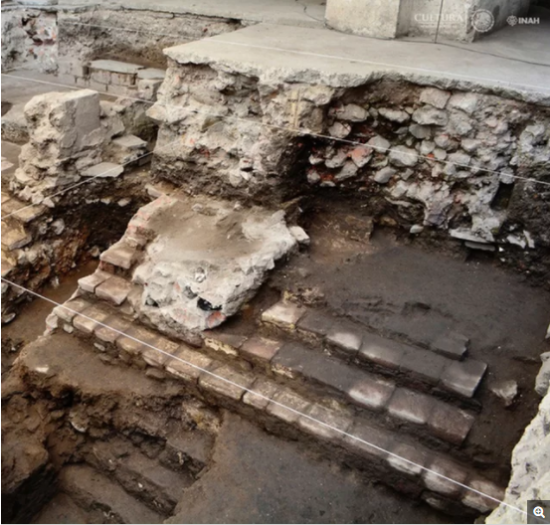Mindy Weisberger
Source - https://www.livescience.com/59468-aztec-temple-in-mexico-city.html
 The remains of a temple dedicated to the Aztec wind god Ehécatl were found at a site in Mexico City. Credit: Héctor Montaño/INAH
The remains of a temple dedicated to the Aztec wind god Ehécatl were found at a site in Mexico City. Credit: Héctor Montaño/INAH
An ancient ceremonial ball court and an Aztec temple dedicated to the wind god Ehécatl have been identified in what is now a modern section of Mexico City.
The 118-foot-long (36 meters) temple and the nearby 30-foot-wide (9 m) ball-court platform were shown to members of the media on June 7, officials with Mexico's National Institute of Anthropology and History (INAH) announced in a statement.
And close by the ball court lay a grisly surprise: sets of neck bones representing about 30 individuals, all infants and children, INAH officials said in the statement.
Researchers identified the temple and ritual ball court after seven years of work as part of an excavation project that began 25 years ago. The project, called the Programa de Arqueología Urbana (PAU), or Urban Archaeology Program, is uncovering the remains of the Aztec capital Tenochtitlan, which was razed in 1521 by Spanish explorer Hernán Cortés.
The site where the temple was found spans seven blocks in Mexico City's historic district, and is located behind the Catedral Metropolitana. Both the temple and the ball court were likely in use from at least A.D. 1481 until 1519, INAH officials said.
 Archaeologists with Mexico's Programa de Arqueología Urbana (Urban Archaeology Program) excavated the ball court near the temple. Credit: PAU/INAH
Archaeologists with Mexico's Programa de Arqueología Urbana (Urban Archaeology Program) excavated the ball court near the temple. Credit: PAU/INAH
Ehécatl was recognized as a god of benign winds that attracted rainfall, Eduardo Matos Moctezuma, researcher emeritus with the INAH, said in the statement. Behind the temple, archaeologists found representations of other deities — Tláloc, a god of rain and agricultural fertility, and the warrior god Huitzilopochtli, located nearby. This arrangement offered a glimpse of hierarchies and relationships within the pantheon of deities in Aztec society, Moctezuma said.
Attached to the large, rectangular temple platform were two circular structures connected by a walkway measuring about 3.6 feet (1.1 m). Near the ball-court platform were the remains of stairs, which players might have used to enter the court, according to Moctezuma.
Under the floor of the ruined stairway, archaeologists found the collection of children's neck bones, which might have belonged to sacrificial victims who were decapitated as offerings to accompany the ritual game, Reuters reported.